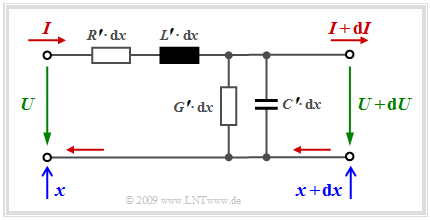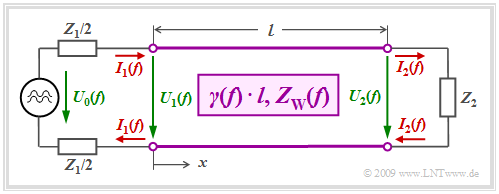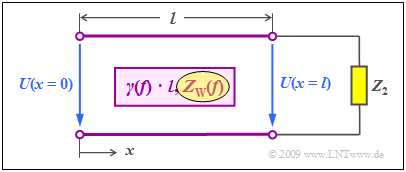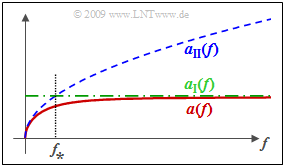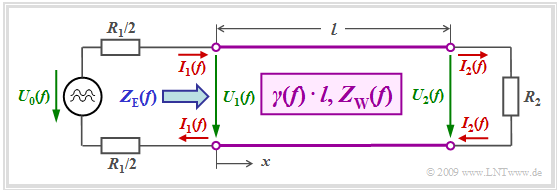Contents
# OVERVIEW OF THE FOURTH MAIN CHAPTER #
A special case of causal and time-invariant systems are electrical cables. Here, due to the Hilbert transformation, a complex-valued frequency response $H(f)$ and strongly unbalanced impulse responses $h(t)$ must always be assumed.
The fourth chapter presents a summary of »conducted transmission channels«, specifically
- important »results and descriptive quantities of Line Transmission Theory«, in particular primary line parameters, complex propagation function (per unit length), attenuation function (per unit length), phase function (per unit length), wave impedance, and the operational attenuation to take account of mismatches and reflections,
- the »frequency responses and impulse responses of coaxial cables«, in which, due to good shielding, all other noise is negligible compared to thermal noise (Gaussian distributed and white), and
- the »description of symmetrical copper cables«, which are the main transmission medium in the »access network of telecommunication systems«. Since many pairs run in parallel in a cable, crosstalk occurs due to capacitive and inductive couplings.
Equivalent circuit diagram of a short transmission line section
To derive the line equations, first a very short line section of length ${\rm d}x$ is considered, so that the values for voltage and current
- at the beginning of the line $(U$ resp. $I$ at $x)$ and
- the end of the line $(U + {\rm d}U$ and $I + {\rm d}I$ at $x + {\rm d}x)$
differ only slightly. The diagram below shows the underlying model.
$\text{Or in other words:}$
Let the line length ${\rm d}x$ be very small compared to the wavelength $\lambda$ of the electromagnetic wave propagating along the line, which results because
- there is a magnetic field connected to the current,
- the voltage between the conductors causes an electric field.
All infinitesimal "components" in the equivalent circuit sketched on the right are location-independent for homogeneous lines:
- The inductance of the considered line section is $L\hspace{0.05cm}' \cdot {\rm d}x$, where $L'$ is called serial inductance per unit length.
- Similarly, the parallel capacitance per unit length $(C\hspace{0.05cm}')$ is an infinitesimally small quantity which, similar to $L'$, depends only slightly on frequency.
- The parallel conductance per unit length $(G\hspace{0.05cm}')$ takes into account the losses of the dielectric between the wires. It increases approximately proportionally with frequency.
- By far the largest (negative) influence on signal transmission is the serial resistance per unit length $(R\hspace{0.05cm}')$, which increases almost proportionally with the root of the frequency for high frequencies due to the so-called "Skin effect".
From the mesh and node equations of the line section, $ω = 2πf$ results in the two difference equations:
- $$ U = I \cdot (R\hspace{0.05cm}' + {\rm j} \cdot \omega L\hspace{0.05cm}') \cdot {\rm d}x + (U + {\rm d}U)\hspace{0.05cm},$$
- $$ I = (U + {\rm d}U) \cdot (G\hspace{0.05cm}' + {\rm j} \cdot \omega C\hspace{0.05cm}') \cdot {\rm d}x + (I + {\rm d}I)\hspace{0.05cm}. $$
For very short line sections $($infinitesimally small ${\rm d}x)$ and neglecting the small second order quantities $($for example ${\rm d}U \cdot {\rm d}x)$ , one can now form two differential quotients whose joint consideration leads to a second order linear differential equation:
- $$\frac{ {\rm d}U}{ {\rm d}x} = - (R\hspace{0.05cm}' + {\rm j} \cdot \omega L\hspace{0.05cm}') \cdot I,\hspace{0.5cm} \frac{ {\rm d}I}{ {\rm d}x} = - (G\hspace{0.05cm}' + {\rm j} \cdot \omega C\hspace{0.05cm}') \cdot U\hspace{0.3cm} \Rightarrow \hspace{0.3cm}\frac{{\rm d}^2U}{{\rm d}x^2} = (R\hspace{0.05cm}' + {\rm j} \cdot \omega L\hspace{0.05cm}') \cdot (G\hspace{0.05cm}' + {\rm j} \cdot \omega C\hspace{0.05cm}') \cdot U\hspace{0.05cm}.$$
The solution of this differential equation is:
- $$U(x) = U_{\rightarrow}(x=0) \cdot {\rm e}^{-\hspace{0.02cm}\gamma \hspace{0.03cm} \cdot \hspace{0.05cm}x} + U_{\leftarrow}(x=0) \cdot {\rm e}^{\gamma \hspace{0.03cm} \cdot \hspace{0.05cm}x} \hspace{0.05cm}.$$
The voltage curve depends not only on the location $x$ but also on the frequency $f$ which is not explicitly noted in the equation given here.
Formula-wise, this frequency dependence is captured by the complex propagation function per unit length:
- $$\gamma(f) = \sqrt{(R\hspace{0.05cm}' + {\rm j} \cdot 2\pi f \cdot L\hspace{0.05cm}') \cdot (G\hspace{0.05cm}' + {\rm j} \cdot 2\pi f \cdot C\hspace{0.05cm}')} = \alpha (f) + {\rm j} \cdot \beta (f)\hspace{0.05cm}.$$
The last two equations together describe the voltage curve along the line, which results from the superposition of a wave $U_→(x)$ running in the positive $x$ direction and the wave $U_←(x)$ in the opposite direction.
- The real part $α(f)$ of the complex propagation function $γ(f)$ attenuates the propagating wave and is therefore called attenuation function per unit length. This always even function ⇒ $α(-f) = α(f)$ results from the above $γ(f)$ equation as follows:
- $$\alpha(f) = \sqrt{{1}/{2}\cdot \left (R\hspace{0.05cm}' \cdot G\hspace{0.05cm}' - \omega^2 \cdot L\hspace{0.05cm}' \cdot C\hspace{0.05cm}'\right)+ {1}/{2} \cdot \sqrt{(R\hspace{0.05cm}'\hspace{0.05cm}^2 + \omega^2 \cdot L\hspace{0.05cm}'\hspace{0.05cm}^2) \cdot (G\hspace{0.05cm}'\hspace{0.05cm}^2 + \omega^2 \cdot C\hspace{0.05cm}'\hspace{0.05cm}^2)}} \bigg |_{\hspace{0.05cm}\omega \hspace{0.05cm}= \hspace{0.05cm}2\pi f}.$$
- The odd imaginary part ⇒ $β(- f) = - β(f)$ is called phase function per unit length and describes the phase rotation of the wave along the line:
- $$\beta(f) = \sqrt{ {1}/{2}\cdot \left (-R\hspace{0.05cm}' \cdot G\hspace{0.05cm}' + \omega^2 \cdot L\hspace{0.05cm}' \cdot C\hspace{0.05cm}'\right)+ {1}/{2} \cdot \sqrt{(R\hspace{0.05cm}'\hspace{0.05cm}^2 + \omega^2 \cdot L\hspace{0.05cm}'\hspace{0.05cm}^2) \cdot (G\hspace{0.05cm}'\hspace{0.05cm}^2 + \omega^2 \cdot C\hspace{0.05cm}'\hspace{0.05cm}^2)}} \bigg |_{\hspace{0.05cm}\omega \hspace{0.05cm}= \hspace{0.05cm}2\pi f}.$$
Wave impedance and reflections
We consider a homogeneous line of length $l$ with a harmonic oscillation $U_0(f)$ of frequency $f$ applied to its input.
- The transmitter has the internal resistance $Z_1$, the receiver has the input impedance $Z_2$ (this is also the terminating resistor of the line).
- We assume for simplicity that $Z_1$ and $Z_2$ are real resistors.
The current and voltage of the outgoing and return waves are linked via the wave impedance $Z_{\rm W}(f)$ :
- $$I_{\rightarrow}(x, f) = \frac{U_{\rightarrow}(x, f)}{Z_{\rm W}(f)}\hspace{0.05cm}, $$
- $$ I_{\leftarrow}(x, f) = \frac{U_{\leftarrow}(x, f)}{Z_{\rm W}(f)}\hspace{0.05cm}.$$
The following applies to the wave impedance:
- $$Z_{\rm W}(f) = \sqrt{\frac {R\hspace{0.05cm}' + {\rm j} \cdot \omega L\hspace{0.05cm}'}{G\hspace{0.05cm}' + {\rm j} \cdot \omega C\hspace{0.05cm}'}} \hspace{0.1cm}\bigg |_{\hspace{0.05cm}\omega \hspace{0.05cm}= \hspace{0.05cm}2\pi f}.$$
- The wave traveling in the positive $x$ direction is generated by the AC voltage source at the beginning of the line $($so at $x = 0)$ .
- The backward wave is only generated by the reflection of the forward wave at the end of the line $(x = l)$:
- $$U_{\leftarrow}(x = l) = {U_{\rightarrow}(x = l)}\cdot \frac{Z_2 -Z_{\rm W}(f)}{Z_2 + Z_{\rm W}(f)}\hspace{0.05cm}.$$
- At this point, the terminating resistor $Z_2$ forces a fixed relationship between the voltage and the current:
- $$U_2(f) = Z_2 · I_2(f).$$
$\text{Conclusion:}$ It can be seen from the above equation that there is no returning wave only for $Z_2 = Z_{\rm W}(f)$ .
- Such resistance matching is always sought in Communications Engineering.
- This matching is not possible over a larger frequency range with fixed termination $Z_2$ due to the frequency dependence of the wave impedance $Z_{\rm W}(f)$ .
In the following, these equations are explained with an example.
$\text{Example 1:}$ We consider the case shown on the right:
- The terminating resistor $Z_2$ of the line (at the same time the input impedance of the following receiver) differs from the wave impedance $Z_{\rm W}(f)$.
- We disregard the mismatch at the beginning of the line.
The diagram below from [Han17][1] is intended to make clear how the resulting wave $U(x)$ - shown as a solid curve - differs from the outgoing wave $U_→(x)$.
To clarify:
- Marked in red is the outgoing wave $U_→(x)$ which starting from the transmitter ⇒ $U_→(x = 0)$ , attenuates along the line. $U_→(x = l)$ denotes the wave at the end of the line.
- Due to the mismatch ⇒ reflection results in the returning wave $U_←(x)$ from the end of the line to the transmitter, marked in green. For this the following applies at the end of the line $(x = l)$:
- $$U_{\leftarrow}(x = l) = {U_{\rightarrow}(x = l)}\cdot \frac{Z_2 -Z_{\rm W}(f)}{Z_2 + Z_{\rm W}(f)}\hspace{0.05cm}.$$
- The resulting (blue) wave $U(x)$ results from the in-phase addition of these two parts which are not visible by themselves.
- As $x$ increases, $U(x)$ becomes smaller, as does $U_→(x)$ due to line attenuation. Also the returning wave $U_←(x)$ is attenuated with increasing length (here from right to left).
Lossless and low-loss lines
$\text{Definition:}$ For very short coaxial lines, such as those used for connections of high-frequency measuring instruments in the laboratory, from $R\hspace{0.05cm}' \approx 0$ and $G\hspace{0.05cm}' \approx 0$ can be assumed. One then speaks of a "lossless line". For such a line, the above equations simplify:
- Attenuation function per unit length: $($please note the difference between "a" and "alpha"$)$.
- $$\alpha(f) = \frac{\text{attenuation function }\ a(f)} {\text{length }\ l } = 0\hspace{0.05cm}.$$
- Phase function per unit length:
- $$\beta(f) = \frac{\text{phase function }\ b(f)} {\text{length }\ l } = 2\pi \cdot f \cdot \sqrt{L\hspace{0.05cm}' \cdot C\hspace{0.05cm}' }\hspace{0.05cm}, $$
- Wave impedance:
- $$Z_{\rm W}(f) = \sqrt{ {L\hspace{0.05cm}'}/{ C\hspace{0.05cm}'} }\hspace{0.05cm}.$$
If $L\hspace{0.05cm}'$ and $C\hspace{0.08cm}'$ are constant in the considered frequency range, the (real) wave impedance $Z_{\rm W}(f)=Z_{\rm W}$ is also frequency independent and the phase function per unit length ⇒ $β(f)$ is proportional to the frequency.
- This means that a lossless line is always free of distortion.
- The output signal can only have a transit time ("delay") compared to the input signal.
- Common wave impedances are $Z_{\rm W} = 50 \ \rm Ω$, $Z_{\rm W} = 75 \ \rm Ω$ and $Z_{\rm W} = 150 \ \rm Ω$.
$\text{Definition:}$ One speaks of a low-loss line when the line is somewhat longer, but cannot yet be called "long".
The given formula for the attenuation function per unit length ⇒ $\alpha(f)$ is now to be evaluated for the case of constant primary line parameters, which does not quite correspond to reality.
- Above a characteristic frequency $f_∗$ that depends on $R\hspace{0.05cm}', \ L\hspace{0.05cm}', \ G\hspace{0.08cm}'$ and $C\hspace{0.08cm}'$, the serial resistance per unit length $(R\hspace{0.05cm}')$ can be assumed to be very small compared to $ωL\hspace{0.05cm}'$ and the parallel conductance per unit length $(G\hspace{0.05cm}')$ can be assumed to be very small compared to $ωC\hspace{0.08cm}'$ula often referred to as weak attenuation, valid for $(f \gg f_∗)$:
- $$\alpha_{_{ {\rm I} } }(f) = {1}/{2} \cdot \left [R\hspace{0.05cm}' \cdot \sqrt{{C\hspace{0.05cm}'}/{ L\hspace{0.05cm}'} } + G\hspace{0.08cm}' \cdot \sqrt{{L\hspace{0.05cm}'}/{ C\hspace{0.08cm}'} }\right ] \hspace{0.05cm}.$$
- On the other hand, for small frequencies $(f < f_∗)$ the serial resistance per unit length $(R\hspace{0.05cm}')$ is much larger than $ωL\hspace{0.05cm}'$ and the parallel conductance per unit length $(G\hspace{0.05cm}')$ is much larger than $ ωC\hspace{0.08cm}'$.
- A second upper bound is obtained, often referred to in literature as strong attenuation, valid for $(f \ll f_∗)$:
- $$\alpha_{_{ {\rm II} } }(f) = \sqrt{ 1/2 \cdot \omega \cdot {R\hspace{0.05cm}' \cdot C\hspace{0.08cm}'} }\hspace{0.1cm} \bigg |_{\omega \hspace{0.05cm}= \hspace{0.05cm}2\pi f}\hspace{0.05cm}.$$
The diagram shows the attenuation function per unit length $α(f)$ at constant primary line parameters according to the exact (but more complicated) formula and the two bounds $α_{\rm I}(f)$ and $α_{\rm II}(f)$.
One recognizes from this representation:
- Both $α_{\rm I}(f)$ and $α_{\rm II}(f)$ are upper bounds for $α(f)$.
- The characteristic frequency $f_∗$ is the intersection of $α_{\rm I}(f)$ and $α_{\rm II}(f)$.
- For $f \gg f_∗$ holds $α(f) ≈ α_{\rm I}(f)$, whereas for $f \ll f_∗$ $α(f) ≈ α_{\rm II}(f)$.
Influence of reflections - operational attenuation
The choice of the terminating resistor $Z_2(f) = Z_{\rm W}(f)$ prevents the generation of a reflected wave at the end of the line. In practice, however, an exact matching of these resistors is usually possible only in a very limited frequency range, for example
- due to the complicated frequency dependence of the wave impedance,
- with cables of different designs along a connection,
- when taking into account manufacturing tolerances.
Therefore, in real systems, the internal resistance $R_1$ of the source and the terminating resistance $R_2$ are usually chosen to be real and constant. For example, in ISDN ("Integrated Services Digital Network") $R_1 = R_2 = 150 \ \rm Ω$ has been set.
This circuit simplification has the following effects:
(1) The input impedance (German: "Eingangswiderstand" ⇒ subscipt "E") $Z_{\rm E}(f)$ of the line as seen from the source depends
- on the complex propagation function per unit length ⇒ $γ(f)$,
- the line length $l$,
- the wave impedance $Z_{\rm W}(f)$, and
- the terminating resistance $R_2$:
- $$Z_{\rm E}(f) = Z_{\rm W}(f)\cdot \frac {R_2 + Z_{\rm W}(f) \cdot {\rm tanh}(\gamma(f) \cdot l)} {Z_{\rm W}(f)+ R_2 \cdot {\rm tanh}(\gamma(f) \cdot l)} \hspace{0.05cm}, \hspace{0.5cm} {\rm with}\hspace{0.5cm}{\rm tanh}(x) = \frac {{\rm sinh}(x)}{{\rm cosh}(x)} = \frac {{\rm e}^{x}-{\rm e}^{-x}}{{\rm e}^{x}+{\rm e}^{-x}}\hspace{0.05cm}, \hspace{0.3cm}x \in {\cal C} \hspace{0.05cm}.$$
(2) This circuit-related simplification ⇒ $Z_{\rm 2}(f) = R_2$ results in reflections at the end of the line. These reduce the power available at the receiver and thus increase the line attenuation.
(3) For the evaluation of such a mismatched system, the operational attenuation ("attenuation in operation", German: "Betriebsdämpfung" ⇒ subscipt "B") has been defined as follows:
- $${ a}_{\rm B}(f) \hspace{0.15cm}{\rm in} \hspace{0.15cm}{\rm Neper}\hspace{0.15cm}{\rm (Np)} = {\rm ln}\hspace{0.1cm}\frac {|U_0(f)|}{2 \cdot |U_2(f)|} \cdot \sqrt{{R_2}/{R_1}} = \alpha (f ) \cdot l + {\rm ln}\hspace{0.1cm}|q_1(f)| + {\rm ln}\hspace{0.1cm}|q_2(f)| + {\rm ln}\hspace{0.1cm}|1 - r_1(f) \cdot r_2(f) \cdot {\rm e}^{-\gamma(f) \hspace{0.05cm} \cdot \hspace{0.05cm}l}| \hspace{0.05cm}.$$
$\text{Example 2:}$ This equation will now be discussed using the above block diagram $($valid for ISDN$)$. We consider the general case of a mismatched system:
- $$R_2 ≠ Z_{\rm W}(f).$$
- The "operational attenuation" defined above relates the actual active power transmitted from the sender to the receiver to the best possible case
$($negligible line length, full matching$)$. - For resistance matching, the operational attenuation is equal to the wave attenuation. In this case, only the first term of the above equation is effective:
- $$a_{\rm B}(f) = \alpha (f ) \cdot l \hspace{0.05cm}.$$
- The second and third terms take into account the power losses due to reflection at the transitions from the transmitter to the line and from the line to the receiver.
For these two reflection losses holds:
- $$q_1(f)= \frac {R_1 + Z_{\rm W}(f)}{2 \cdot \sqrt{R_1 \cdot Z_{\rm W}(f)} } \hspace{0.05cm}, \hspace{0.3cm}q_2(f)= \frac {R_2 + Z_{\rm W}(f)}{2 \cdot \sqrt{R_2 \cdot Z_{\rm W}(f)} } \hspace{0.05cm}.$$
- The interaction attenuation (fourth term) describes the effect of a multiple reflected wave, which – depending on the line length – is constructively or destructively superimposed on the useful signal at the receiver. The following applies to these reflection factors:
- $$r_1(f)= \frac {R_1 - Z_{\rm W}(f)}{R_1 + Z_{\rm W}(f)} \hspace{0.05cm}, \hspace{0.3cm}r_2(f)= \frac {R_2 - Z_{\rm W}(f)}{R_2 + Z_{\rm W}(f)} \hspace{0.05cm}.$$
The various components of the operational attenuation $a_{\rm B}(f)$ are calculated in Exercise 4.3 for a practical example.
$\text{Please note:}$ In the following chapters for
- Coaxial Cables, and
- Balanced Copper Pairs
only the wave attenuation $α(f)\cdot l$ is further considered and thus the effects of error matching are neglected.
Exercises for the chapter
Exercise 4.1: Attenuation Function
Exercise 4.1Z: Transmission Behavior of Short Cables
Exercise 4.3: Operational Attenuation
List of sources
- ↑ Hanik, N.: Leitungsgebundene Übertragungstechnik. Lecture notes. Chair of Communications Engineering, TU München, 2017.
